
Elkmont History
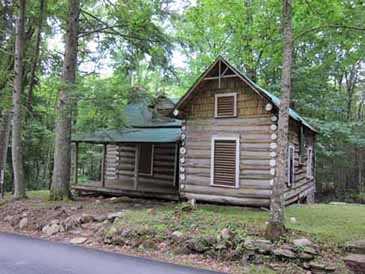 |
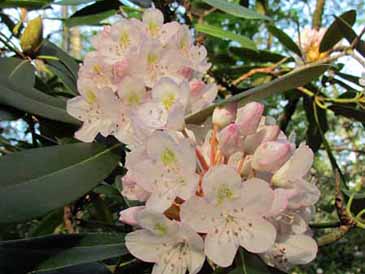 |
| Historic Cabin in Elkmont | Mountain Laurel in Elkmont |
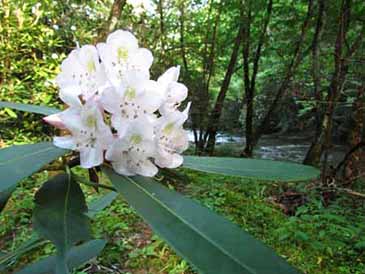 |
 |
| Mountain Laurel in Elkmont | Historic Cabin in Elkmont |
Beginning as a rough and tumble logging town, Elkmont gradually evolved into a haven for the socially prominent and wealthy members of nearby Knoxville, Maryville, and Chattanooga. Many cottages were built and used for the summer. Today, Elkmont is primarily a campground within Great Smoky Mountains National Park. The peacefulness you will find there is unsurpassed.
Elkmont >>
Like many towns which sprang up during the early part of this century and centered around the utilization of natural resources, Elkmont, Tennessee was quick to expand and just as quick to fade back into small town obscurity.Near Townsend, Tennessee along the banks of the Little River, Elkmont saw its booms and busts. The town saw its beginnings in the early 1900s when three Pennsylvanians, Colonel W. B. Townsend, J. W. Wrigley, and F. H. McCormick, came south searching for virgin timberland. They found large, beautiful stands in the watershed of the Little River. Acquiring 75,000 to 80,000 acres of prime forest land from the previous mountain inhabitants, the Little River Lumber Company was born.
Its headquarters were located in the town which became known as Townsend after the firm's president, Col. Townsend.
Soon after, the Little River Railroad appeared extending from Townsend 18 miles into Elkmont and beyond. Elkmont itself served as a junction between the conventional locomotive, the rod engine, and the "Shays" or geared locomotive which were used to haul logs from the steeper grades of the higher mountains. Originally built as a logging train, the line became popular with weekend travelers from Knoxville. Col. Townsend soon added an observation deck and a passenger car to make those travelers more comfortable.
The Knoxvillians traveled on the weekends to the area to engage in some of the best hunting and fishing around. Trout, bear, deer, and smaller game animals were abundant. The men reached Elkmont by a long route beginning in Knoxville on the Southern Railway Line. They rode to Walland and Townsend and then transferred to the Little River Railroad for the final stretch into Elkmont.
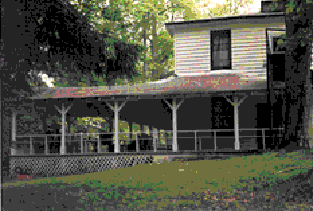 Wonderland Hotel |
In 1910, the Little River Lumber Co. deeded a tract of 50 acres of land to the existing Appalachian Club on which the group erected a clubhouse. Founded in 1907, the Appalachian Club was a hunting and fishing club of which many of the Knoxville weekenders were members. A few months later, the lumber company accorded the club a 10-year lease of exclusive hunting and fishing privileges to the Appalachian Club covering some 40,000 acres on the headwaters on the Little River above Elkmont. The Club was to undertake all game and fish management of the area.
Originally established as a sportsmen's club, the Appalachian Club soon grew more social in its activities. The men's womenfolk heard of the beauty and fun in the forests of Elkmont and soon joined their husbands on their weekend trips. A hotel annex was added to the clubhouse. It later burned down and was never rebuilt. This hotel served as a place for bridge tournaments, dances and other social functions.
Beginning as a rough and tumble logging town, Elkmont gradually evolved into a haven for the socially prominent and wealthy members of Knoxville, Maryville, and Chattanooga. Many cottages were built and used for the summer. Until recently, 50 or more were inhabited by third or fourth generations of the original owners. The Appalachian Club became rather exclusive as well, denying access to its facilities and functions to all outsiders.
A beautiful area in the summer, Elkmont provided a haven away from the hassles of the city for some of its residents. However, the mainstay of the town was still timber operations. In its heyday in the 1920s, Elkmont was the second largest town in Sevier County. Among the many homes and cottages existed a general store, post office, boarding house, church and theater.
Early travelers reached the area on foot or horseback along a hazardous 7-1/2 mile route from Gatlinburg. As noted before, the railways also brought in many visitors and residents with accommodations on the logging train not always very comfortable. Later a rough, narrow road was graded from Gatlinburg to the area. When the railroad was discontinued in 1926, its rails and cross-ties were removed and gravel was laid to make a better road. The present Elkmont road still has as its base the former railroad bed.
Besides the Appalachian Club and the area's many homes, Elkmont had in its vicinity a glorious hotel. As lands became clear-cut the Little River Lumber Co. sold off more and more of its holdings. The largest piece sold was in 1912 to the three Carter brothers, John P., Charles P., and A. E. Their company, The Wonderland Park Company, built the Wonderland Park Hotel on this 65 acre tract of land.
Besides the Appalachian Club and the area's many homes, Elkmont had in its vicinity a glorious hotel. As lands became clear-cut the Little River Lumber Co. sold off more and more of its holdings. The largest piece sold was in 1912 to the three Carter brothers, John P., Charles P., and A. E. Their company, The Wonderland Park Company, built the Wonderland Park Hotel on this 65 acre tract of land.
In 1914, the land and hotel were sold to a group of Knoxvillians who had been denied access to the Appalachian Club. They formed their own club and the Wonderland Club's Hotel was born with an additional hotel annex. Some of the rooms were owned by the members and others were rented out to the public. It was surrounded by hundreds of miles of trails and was a mecca for hikers. A white, two-story clapboard structure, the hotel was surrounded on the front and one side by a large porch complete with rockers and swings. The scenery is breathtaking, and many came there to escape from the outside world.
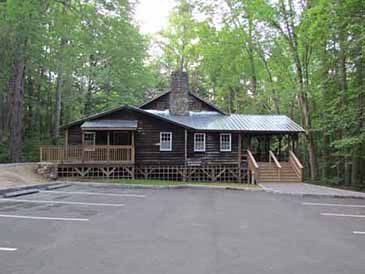 |
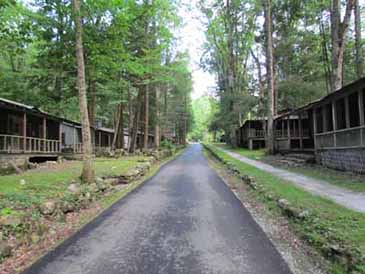 |
| Appalachian Clubhouse | Cabins in Historic Elkmont |
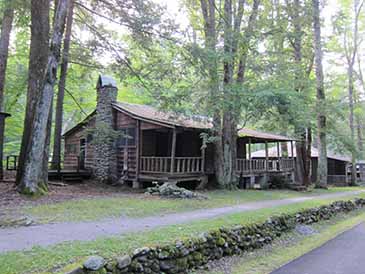 |
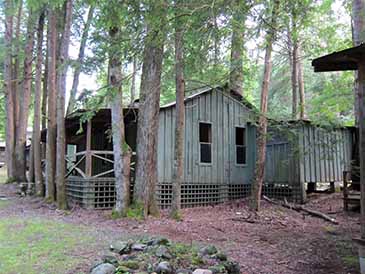 |
| Cabin in Historic Elkmont | Cabin in Historic Elkmont |
Another tract of land was sold to Appalachian Club member, R. S. Hommel. Here Mr. Hommel planted acres and acres of apple trees and began a successful apple orchard business.
Minor problems and disturbances including a train wreck livened up the town but mostly things ran smoothly. The area was excellent for fishing and hunting, fresh vegetables were available from gardens and from Gatlinburg. People were friendly to one another and major problems non-existent.
All that changed when talk about a national park began to circulate. There were two sides on the issue--one wished for a national park and one wanted the area to be preserved as a national forest. Colonel David C. Chapman was the driving force behind the national park for he wanted roads and facilities erected so all Americans could enjoy the area. He also believed the visitors would bring in money for local businesses.
James Wright, a Knoxville lawyer and owner of a cottage in Elkmont, led the opposition. A dedicated conservationist, Wright believed the area would be contaminated by hoards of crowds. He thought the area would be best protected if classified as a national forest.
In the end, the national park idea won out. Col. Townsend helped in its creation by agreeing to sell 76,500 mountain acres to the state which would then be transferred to the Federal Government. He also agreed to give up his lumbering empire. The town was facing its demise, for the public was not allowed to reside in national parks. Logging operations were stopped and the government began to buy the homeowners' property. Great opposition arose from the residents and members of the Appalachian Club. They hired James Wright to defend their rights in court. Neither side would back down and no compromise was in sight. The State Park Commission was faced with two conclusions: either exclude the area in question from the proposed park or acquire the lands through purchase at the discretion of the owners and at their stated price. The National Park Service would not agree to the exclusion, and the Commission did not have the funds to pay the owners' set prices.
A solution was finally found when the Commission and the Secretary of the Interior devised a plan whereby the landowners would be offered long-term leases to live on the property which would be purchased by the government at reduced rates. Upon grudging Congressional consent, the plan went into effect.
The Great Smoky Mountains National Park became a reality in 1934, and the residents of Elkmont remained in their homes now owned by the Government. However, the battle was not completely over. The leases expired in 1972 but were renewed for another 20 years among much criticism. About 50 leases expired on December 31, 1992 and four more expired on December 31, 2001.
More Information
| WELCOME TO GREAT SMOKY MOUNTAINS NATIONAL PARK Trip Ideas Great Smoky Mountains Facts Policies Institute at Tremont Order Your Free Visitor's Guide Transportation & Airports Local News Photo Tours • Fall Photo Tour • Roaring Fork Motor Nature Trail • Smoky Mountain Fall Foliage • Fall Foliage at Clingmans Dome • Fall Colors in nearby Villages • Fall in Wears Valley • Best Fall Hikes in the Smokies |
WHAT TO DO Attractions Biking Fishing Hiking Outdoor Adventure Scenic Drives and Rides Shopping Heritage, History, & Culture Nature Activities |
WHERE TO STAY Bed & Breakfast Cabins Camping Condos Hotels WHERE TO EAT |
4 SEASONS Winter Spring Summer Fall WEDDINGS Wedding Services Honeymoon Cabins |
Surrounding Towns: • Cherokee • Gatlinburg • Maggie Valley • Pigeon Forge • Townsend • Wears Valley CONTACT Contact Add Your Site Advertise
|
